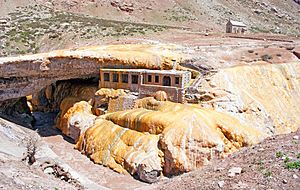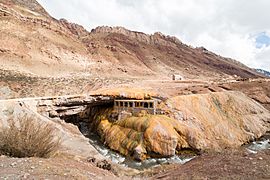Puente del Inca facts for kids
Puente del Inca means "Bridge of the Inca" in English. It is a cool natural arch that looks like a bridge. This natural bridge goes over the Las Cuevas River. This river then flows into the Mendoza River.
You can find Puente del Inca near a small village also called Puente del Inca. This village is in the Mendoza Province of Argentina. There are also hot springs nearby with the same name. Even though the bridge shows some wear, it is still strong and safe.
How the Bridge Formed
This amazing natural bridge was made by two things working together: glaciers and hot springs. A long time ago, during an ice age, huge glaciers covered the valley. As the Earth got warmer, the glaciers melted and moved back. They left behind big piles of rocks and dirt.
The water from the hot springs here has lots of minerals. These minerals can turn small objects into stone by covering them in a hard layer. Over time, these minerals also covered the piles of rocks left by the glaciers. This turned the loose piles into one solid, hard mass.
Later, during a very wet period, a powerful river flowed through the valley. This river slowly cut a path through the softer parts of the mineral-covered rock. This cutting and wearing away created the large opening we see today, forming the natural arch.
History of Puente del Inca
Many years ago, in March 1835, a famous scientist named Charles Darwin visited Puente del Inca. He was so impressed that he drew pictures of the bridge. He also noted the large, hanging rock formations, like icicles, called stalactites.
In the early 1900s, this area became a popular place for people to visit. A big resort and a monastery were built here. People came to use the hot springs, believing the mineral-rich water could help with certain illnesses. There is still a spa further down the river at Cacheuta.
Tourists used to arrive at the resort by train. The old railway station is still there, but trains no longer run on that line. This station was one of the last stops in Argentina for the Transandine Railway. This train line used to travel through a long tunnel under the Andes mountains into Chile.
Today, the area is a starting point for climbers heading to Aconcagua. This is the highest mountain in the Western Hemisphere. The old railway station has been turned into a museum. It's called "Museo del Andinista," which means "Mountaineer's Museum." A group of mountain climbers from Rosario started it. The museum shows the history of climbing and the local culture. It's open to visitors during the summer.
Geography and Climate
Puente del Inca is very high up, about 2,744 meters (9,003 feet) above sea level. Because it's so high and far from the ocean, it has a special kind of climate. It's called a warm-summer continental climate. This means it has warm, dry summers and snowy winters.
This type of climate is quite rare in South America. It happens here because Puente del Inca is far enough from the Pacific Ocean to have big temperature changes between seasons. It's also on the side of the Andes mountains that is sheltered from the wind. Even though the climate is continental, the plants and trees here look more like those found in a cold, dry area.
Gallery
See also
 In Spanish: Monumento natural Puente del Inca para niños
In Spanish: Monumento natural Puente del Inca para niños






